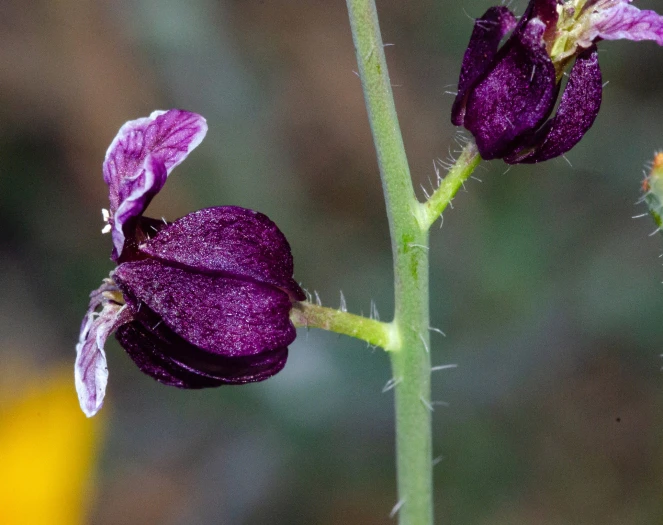Bristly Jewelflower
(Streptanthus glandulosus)
Bristly Jewelflower (Streptanthus glandulosus)
/
/

Don Loarie
CC BY 4.0
Image By:
Don Loarie
Recorded By:
Copyright:
CC BY 4.0
Copyright Notice:
Photo by: Don Loarie | License Type: CC BY 4.0 | License URL: http://creativecommons.org/licenses/by/4.0/ | Rights Holder: Don Loarie | Publisher: iNaturalist | Date Created: 2020-06-11T08:34:22-07:00 |

























Estimated Native Range
Climate Requirements for Brunswick, Ohio
| This Plant | Your Site | Plant Suitability for Your Location | ||
|---|---|---|---|---|
| • Precipitation | 14" - 58" | 38" | Aquatic | Aquatic |
| • High Temp. | 72°F - 100°F | 82°F | Your summer temperatures are normal for this plant. | Excellent |
| • Low Temp. | 32°F - 43°F | 17°F | Your winter temperatures may be too cold for this plant | Too cold |
This plant may not grow well at your location - your precipitation is too high.
Summary
Streptanthus glandulosus, commonly known as bristly jewelflower, is an annual herb native to the serpentine soils of chaparral, woodlands, and grasslands in California and southwestern Oregon. The plant typically grows from 4 inches to over 3 feet tall, with a variable degree of hairiness. Basal leaves are borne on winged petioles, and the flowers are distinctive with an urn-shaped calyx that can be green, purple, or yellow, with purple or white petals protruding from the tip. The fruit is a straight or curving silique that can grow up to 4 inches long.
The bristly jewelflower is appreciated for its unique floral structure and is often used in native plant gardens and restoration projects. It is adapted to serpentine soils, which are typically low in essential nutrients and high in heavy metals, making it a valuable species for habitat-specific gardening. In cultivation, it requires well-drained soils and full sun to part shade conditions. While not a common garden plant, it can be a conversation starter due to its unusual appearance and adaptation to challenging soil conditions. It is relatively low maintenance, but it can be susceptible to fungal diseases in overly moist conditions.CC BY-SA 4.0
The bristly jewelflower is appreciated for its unique floral structure and is often used in native plant gardens and restoration projects. It is adapted to serpentine soils, which are typically low in essential nutrients and high in heavy metals, making it a valuable species for habitat-specific gardening. In cultivation, it requires well-drained soils and full sun to part shade conditions. While not a common garden plant, it can be a conversation starter due to its unusual appearance and adaptation to challenging soil conditions. It is relatively low maintenance, but it can be susceptible to fungal diseases in overly moist conditions.CC BY-SA 4.0
Plant Description
- Plant Type: Herb
- Height: 2-2.5 feet
- Width: 0.5-1 feet
- Growth Rate: Moderate
- Flower Color: Pink, Purple
- Flowering Season: Spring, Summer
- Leaf Retention: Deciduous
Growth Requirements
- Sun: Full Sun, Part Shade
- Water: Low, Medium
- Drainage: Medium
Common Uses
Bee Garden, Bird Garden, Butterfly Garden, Low Maintenance
Natural Habitat
Native to the serpentine soils of chaparral, woodlands, and grasslands in California and southwestern Oregon
Other Names
Common Names: Sticky Jewelflower, Jewel-Flower, Glandular Jewelflower
Scientific Names: Streptanthus glandulosus, Erysimum glandulosum, Euclisia albida, Euclisia bakeri, Euclisia elatior, Euclisia glandulosa, Euclisia versicolor, Euclisia violacea, Euklisia glandulosa
GBIF Accepted Name: Streptanthus glandulosus